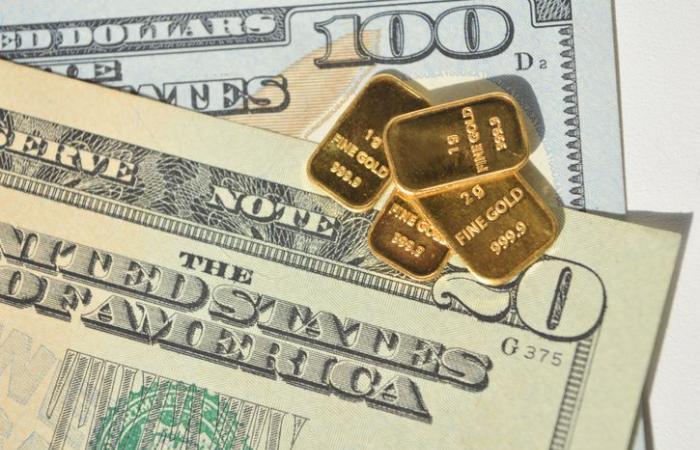Gold, a universal symbol of wealth and security, plays an essential role in investment strategies, particularly in times of economic turbulence. For decades, its relationship with the US dollar and US economic policies has been a barometer of global financial markets. Under the presidency of Donald Trump, this dynamic has intensified: on the one hand, a dollar oscillating according to economic promises and geopolitical tensions; on the other, a precious metal regaining its shine in the face of growing uncertainty.
In November 2024, gold reached €2,440 per ounce (around $2,600) and continues to be popular with investors. This success results from complex mechanisms linking political instability, economic uncertainties and global strategies. How is political and economic instability fueling the rise of gold? Let’s decipher this question through recent upheavals.
Gold in the face of the Trump presidency: a safe haven in action
The election of Donald Trump in 2016 immediately upset the global economic balance. On paper, his ambitious economic strategy, called “Trumponomics”, promised to boost American growth via significant tax cuts and an infrastructure investment plan. This vision initially appealed to investors: the US dollar strengthened, reaching record highs in 2017, while gold, often neglected in periods of economic confidence, fell below $1,200 per ounce.
However, the limits of this policy quickly became apparent. The implementation of tax reforms and infrastructure projects has been hampered by legislative and administrative blockages. The economic consequences have raised serious concerns: explosion of public deficits, inflationary fears, and loss of international competitiveness. These factors, combined with Trump's geopolitical decisions – trade war with China, withdrawal from climate agreements, and increased tensions with Iran – have amplified global instability.
Faced with these uncertainties, investors sought refuge in gold, which returned to an upward dynamic in 2018, crossing the threshold of $1,300 per ounce. This recovery intensified with the rise of Sino-American trade tensions in 2019. This conflict, marked by reciprocal customs sanctions and bellicose speeches, exacerbated fears of a global economic slowdown.
The attraction of gold, however, goes beyond simple cyclical responses. Unlike the dollar, which is dependent on American political decisions, gold is universal and independent. Its role goes beyond hedging against uncertainty: it acts as a structurally stable asset, escaping monetary manipulation.
The XAU/USD pair under influence: from the Trump effect to market resilience
The relationship between the US dollar and gold is based on a simple but powerful principle: their inverse correlation. When the dollar strengthens, foreign investors must pay more to acquire gold, dampening demand. Conversely, a weakened dollar stimulates the appeal of the yellow metal. Under the Trump presidency, this mechanism has taken on an unprecedented scale, exacerbated by political oscillations and unpredictable economic decisions.
In 2017, the dollar's strength was driven by optimistic expectations around a Federal Reserve ready to raise interest rates. But from 2018, trade tensions, record budget deficits, and declines in bond yields weakened the greenback. Gold, on the other hand, benefited from double support: on the one hand, demand from investors seeking a hedge against uncertainty; on the other, strategic purchases by central banks, particularly in Asia and Eastern Europe.
In 2024, with the price reaching $2,600 per ounce, gold remains at the heart of investment strategies. According to forecasts, this upward trend could continue. Goldman Sachs anticipates a price reaching $3,000 by the end of 2025, while UBS mentions a slightly lower threshold, at $2,900. These estimates are based on several factors: negative real interest rates, growing institutional demand, and persistent geopolitical tensions.
Another key factor for the future of gold lies in the global energy transition. Rare metals, including gold, play a role in some advanced technologies. Although their impact is indirect, it helps support demand in the long term.
The XAU/USD pair therefore illustrates a complex dynamic: if the dollar remains a safe haven currency in times of crisis, it cannot match the timeless stability of gold. At a time when currencies are exposed to monetary and budgetary fluctuations, gold is emerging as an alternative standard, essential for risk management.
Gold, a strategic pillar in an uncertain world
The Trump presidency marked a period of unprecedented economic and geopolitical upheaval, but it also offered a striking demonstration of gold's resilience in the face of crises. More than just a safe haven asset, gold has established itself as an indicator of systemic flaws in the global economy. It acts as a constant in a financial system dominated by political uncertainties and expansionary monetary policies.
In 2024, as the global economy continues to navigate an environment marked by geopolitical tensions and inflationary pressures, gold retains a central place in the portfolios of sophisticated investors. It is no longer simply a protective asset, but a strategic pillar, capable of offsetting imbalances and stabilizing portfolios.
Recent history teaches us a fundamental truth: in a world where markets are increasingly volatile, gold remains the compass for investors. As a universal asset, it guides strategies and transcends economic cycles. In the long term, it confirms its role as a pillar of stability, essential in any modern asset allocation.
Also read : The benefits of neurodiversity for effective leadership






